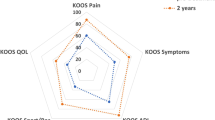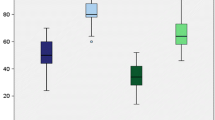Abstract
Fifty-seven consecutive patients (58 knees) with an acute, isolated, posterior cruciate ligament (PCL) injury were treated nonoperatively. Clinical, radiographic, and functional assessment was performed at a mean follow-up of 6.9 years (range 2 to 19.3 years) after the initial diagnosis. At the time of initial documentation of the injury, the posterior drawer test was grade A in 17 knees and grade B in 41 knees. The mean preinjury Tegner activity level was 7 (range 4 to 10). At latest follow-up, 38 knees had no pain, 14 had mild pain, and 6 had moderate pain on exertion. Fifty-four knees had no swelling, 3 had mild, intermittent swelling, and 1 had a moderate swelling on exertion. The posterior drawer test was grade A in 14 knees and grade B in 44 knees. The mean Lysholm-II knee score was 85.2 points (range 51 to 100 points) and the mean Tegner activity level was 6.6 (range 3 to 10). Based on Lysholm-II knee scoring system, the results were excellent in 23 knees (40%), good in 30 knees (52%), fair in 2 knees (3%), and poor in 3 knees (5%). No statistically significant correlation (p = 0.097) was seen between the grade of PCL laxity and Lysholm-II knee score. Plain radiographs showed mild (grade I) medial compartment osteoarthritis (OA) in 7 knees, and moderate (grade II) medial compartment OA in 3 knees. Mild patellofemoral OA was seen in 4 knees. We believe that most patients with acute, isolated PCL injuries do well with nonoperative treatment at a mean follow-up of 6.9 years. The level of evidence for this retrospective cohort study is level III.



Similar content being viewed by others
References
O’Donoghue DH (1959) Surgical treatment of injuries to ligaments of the knee. JAMA 169(13):1423–1431
Clendenin MB, DeLee JC, Heckman JD (1980) Interstitial tears of the posterior cruciate ligament of the knee. Orthopedics 3:764–772
DeHaven KE (1980) Diagnosis of acute knee injuries with hemarthrosis. Am J Sports Med 8(1):9–14
Lysholm J, Gillquist J (1981) Arthroscopic examination of the posterior cruciate ligament. J Bone Joint Surg [Am] 63-A(3):363–366
Hughston JC, Degenhardt TC (1982) Reconstruction of the posterior cruciate ligament. Clin Orthop Relat Res 164:59–77
Parolie JM, Bergfeld JA (1986) Long-term results of nonoperative treatment of isolated posterior cruciate ligament injuries in the athlete. Am J Sports Med 14(1):35–38
Johnson JC, Bach BR Jr (1990) Posterior cruciate ligament [Current concepts review]. Am J Knee Surg 3:143–153
Fanelli GC, Giannotti BF, Edson CJ (1994) The posterior cruciate ligament arthroscopic evaluation and treatment [Current concepts review]. Arthroscopy 10(6):673–688
Schulz MS, Russe K, Weiler A, et al. (2003) Epidemiology of posterior cruciate ligament injuries. Arch Orthop Trauma Surg 123(4):186–191
Clancy WG Jr, Sutherland TB (1994) Combined posterior cruciate ligament injuries. Clin Sports Med 13(3):629–647
Trickey EL (1968) Rupture of the posterior cruciate ligament of the knee. J Bone Joint Surg [Br] 50-B(2):334–341
Cross MJ, Powell JF (1984) Long-term followup of posterior cruciate ligament rupture: a study of 116 cases. Am J Sports Med 12(4):292–297
Fowler PJ, Messieh SS (1987) Isolated posterior cruciate ligament injuries in athletes. Am J Sports Med 15(6):553–557
Kennedy JC, Grainger RW (1967) The posterior cruciate ligament. J Trauma 7(3):367–377
Hughston JC, Bowden JA, Andrews JR, et al. (1980) Acute tears of the posterior cruciate ligament. Results of operative treatment. J Bone Joint Surg [Am] 62-A(3):438–450
Trickey EL (1980) Injuries to the posterior cruciate ligament: diagnosis and treatment of early injuries and reconstruction of late instability. Clin Orthop Relat Res 147:76–81
Fleming RE Jr, Blatz DJ, McCarroll JR (1981) Posterior problems in the knee. Posterior cruciate insufficiency and posterolateral rotatory insufficiency. Am J Sports Med 9(2):107–113
Loos WC, Fox JM, Blazina ME, et al. (1981) Acute posterior cruciate ligament injuries. Am J Sports Med 9(2):86–92
Balkfors B (1982) The course of knee-ligament injuries. Acta Orthop Scand Suppl 198:1–99
Dandy DJ, Pusey RJ (1982) The long-term results of unrepaired tears of the posterior cruciate ligament. J Bone Joint Surg [Br] 64-B(1):92–94
Bianchi M (1983) Acute tears of the posterior cruciate ligament: clinical study and results of operative treatment in 27 cases. Am J Sports Med 11(5):308–314
Clancy WG Jr, Shelbourne KD, Zoellner GB, et al. (1983) Treatment of knee joint instability secondary to rupture of the posterior cruciate ligament. Report of a new procedure. J Bone Joint Surg [Am] 65-A(3):310–322
Satku K, Chew CN, Seow H (1984) Posterior cruciate ligament injuries. Acta Orthop Scand 55(1):26–29
Tibone JE, Antich TJ, Perry J, et al. (1988) Functional analysis of untreated and reconstructed posterior cruciate ligament injuries. Am J Sports Med 16(3):217–223
Torg JS, Barton TM, Pavlov H, et al. (1989) Natural history of the posterior cruciate ligament-deficient knee. Clin Orthop Relat Res 246:208–216
Barrett GR, Savoie FH (1991) Operative management of acute PCL injuries with associated pathology: long-term results. Orthopedics 14(6):687–692
Whipple TL, Ellis FD (1991) Posterior cruciate ligament injuries. Clin Sports Med 10(3):515–527
Flandry FC, Wolfe MW, Martino JA, et al. (1996) The natural history of the posterior cruciate ligament-deficient knee. Orthop Trans 20:7
Longenecker SL, Hughston JC (1987) Long-term follow-up of isolated posterior cruciate injuries. Am J Sports Med 15:628
Dejour H, Walch G, Peyrot J, et al. (1988) The natural history of rupture of the posterior cruciate ligament. Fr J Orthop Surg 2:112–120
Keller PM, Shelbourne KD, McCarroll JR, et al. (1993) Nonoperatively treated isolated posterior cruciate ligament injuries. Am J Sports Med 21(1):132–136
Shino K, Horibe S, Nakata K, et al. (1995) Conservative treatment of isolated injuries to the posterior cruciate ligament in athletes. J Bone Joint Surg [Br] 77–B(6):895–900
Boynton MD, Tietjens BR (1996) Long-term followup of the untreated isolated posterior cruciate ligament-deficient knee. Am J Sports Med 24(3):306–310
Shelbourne KD, Davis TJ, Patel DV (1999) The natural history of acute, isolated, non-operatively treated posterior cruciate ligament injuries. A prospective study. Am J Sports Med 27(3):276–283
Iwamoto J, Takeda T, Suda Y, et al. (2004) Conservative treatment of isolated posterior cruciate ligament injury in professional baseball players: a report of two cases. Knee 11(1):41–44
Toritsuka Y, Horibe S, Hiro-Oka A, et al. (2004) Conservative treatment for rugby football players with an acute isolated posterior cruciate ligament injury. Knee Surg Sports Traumatol Arthrosc 12(2):110–114
Shelbourne KD, Muthukaruppan Y (2005) Subjective results of nonoperatively treated, acute, isolated posterior cruciate ligament injuries. Arthroscopy 21(4):457–461
Tegner Y, Lysholm J (1985) Rating systems in the evaluation of knee ligament injuries. Clin Orthop Relat Res 198:43–49
Hefti F, Müller W, Jakob RP, et al. (1993) Evaluation of knee ligament injuries with the IKDC form. Knee Surg Sports Traumatol Arthrosc 1(3–4):226–234
Lysholm J, Gillquist J (1982) Evaluation of knee ligament surgery results with special emphasis on use of a scoring scale. Am J Sports Med 10(3):150–154
Odensten M, Lysholm J, Gillquist J (1983) Long-term follow-up study of a distal iliotibial band transfer (DIT) for anterolateral knee instability. Clin Orthop Relat Res 176:129–135
Daniel DM, Stone ML, Barnett P, et al. (1988) Use of the quadriceps active test to diagnose posterior cruciate-ligament disruption and measure posterior laxity of the knee. J Bone Joint Surg [Am] 70-A(3):386–391
Jakob RP, Hassler H, Stäubli H-U (1981) Observations on rotatory instability of the lateral compartment of the knee. Experimental studies on the functional anatomy and pathomechanism of the true and reversed pivot shift sign. Acta Orthop Scand Suppl 191:1–32
Noyes FR, Barber-Westin SD, Grood ES (2001) Newer concepts in the treatment of posterior cruciate ligament ruptures. In: Insall JN, Scott WN (eds) Surgery of the knee, 3rd edn. Churchill Livingstone, Philadelphia pp 850–852
MacGillivray JD, Shubin Stein BE, Park M, et al. (2006) Comparison of tibial inlay versus transtibial techniques for isolated posterior cruciate ligament reconstruction: minimum 2-year follow-up. Arthroscopy 22(3):320–328
Rosenberg TD, Paulos LE, Parker RD, et al. (1988) The forty-five-degree posteroanterior flexion weight-bearing radiograph of the knee. J Bone Joint Surg [Am] 70-A(10):1479–1483
Merchant AC, Mercer RL, Jacobsen RH, et al. (1974) Roentgenographic analysis of patellofemoral congruence. J Bone Joint Surg [Am] 56-A(7):1391–1396
Hughston JC, Norwood LA Jr (1980) The posterolateral drawer test and external rotational recurvatum test for posterolateral rotatory instability of the knee. Clin Orthop Relat Res 147:82–87
Rubinstein RA Jr, Shelbourne KD, McCarroll JR, et al. (1994) The accuracy of the clinical examination in the setting of posterior cruciate ligament injuries. Am J Sports Med 22(4):550–557
Stäubli H-U, Jakob RP (1990) Posterior instability of the knee near extension. A clinical and stress radiographic analysis of acute injuries of the posterior cruciate ligament. J Bone Joint Surg [Br] 72-B(2):225–230
Hewett TE, Noyes FR, Lee MD (1997) Diagnosis of complete and partial posterior cruciate ligament ruptures. Stress radiography compared with KT-1000 arthrometer and posterior drawer testing. Am J Sports Med 25(5):648–655
Geissler WB, Whipple TL (1993) Intraarticular abnormalities in association with posterior cruciate ligament injuries. Am J Sports Med 21(6):846–849
Hamada M, Shino K, Mitsuoka T, et al. (2000) Chondral injury associated with acute isolated posterior cruciate ligament injury. Arthroscopy 16(1):59–63
Strobel MJ, Weiler A, Schulz MS, et al. (2003) Arthroscopic evaluation of articular cartilage lesions in posterior-cruciate-ligament-deficient knees. Arthroscopy 19(3):262–268
Skyhar MJ, Warren RF, Ortiz GJ, et al. (1993) The effects of sectioning of the posterior cruciate ligament and the posterolateral complex on the articular contact pressures within the knee. J Bone Joint Surg [Am] 75-A(5):694–699
Acknowledgments
We thank Eva M. Anisko, BA for her help in collaborating the patient data and Margaret G. E. Peterson, PhD for statistical analysis of the data.
Author information
Authors and Affiliations
Corresponding author
Rights and permissions
About this article
Cite this article
Patel, D.V., Allen, A.A., Warren, R.F. et al. The Nonoperative Treatment of Acute, Isolated (Partial or Complete) Posterior Cruciate Ligament-Deficient Knees: An Intermediate-term Follow-up Study. HSS Jrnl 3, 137–146 (2007). https://doi.org/10.1007/s11420-007-9058-z
Published:
Issue Date:
DOI: https://doi.org/10.1007/s11420-007-9058-z




